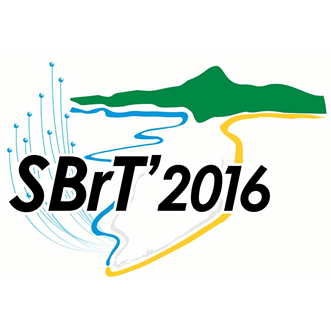
XXXIV Simpósio Brasileiro de Telecomunicações
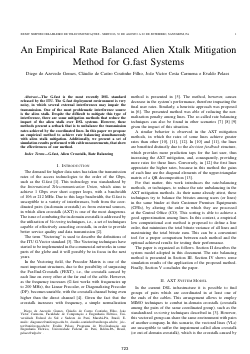
An Empirical Rate Balanced Alien Xtalk Mitigation Method for G.fast Systems
Diego de Azevedo Gomes, Cl´audio de Castro Coutinho Filho, João Victor Costa Carmona, Evaldo Pelaes
DOI: 10.14209/sbrt.2016.221
Keywords: G.fast Alien Crosstalk Rate Balancing
Abstract
The G.fast is the most recently DSL standard released by the ITU. The G.fast deployment environment is very noisy, in which several external interferences may impair the transmission. One of the most problematic interference source is the alien xtalk. Despite the difficult to mitigate this type of interference, there are some mitigation methods that reduce the impact of the alien xtalk over DSL systems. However, these methods present a setback that is to unbalance the transmission rates achieved by the coordinated lines. In this paper we propose an empirical method to achieve rate balancing simultaneously with alien xtalk mitigation. Additionally, we present a set of simulation results performed with cableDownload
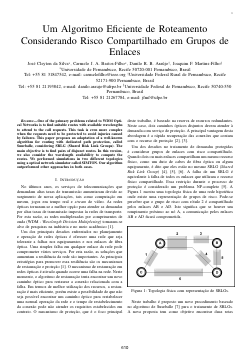
Um Algoritmo Eficiente de Roteamento Considerando Risco Compartilhado em Grupos de Enlaces
José Cleyton da Silva, Carmelo J. A. Bastos-Filho, Danilo R. B. Araújoy, Joaquim F. Martins-Filhoz
DOI: 10.14209/sbrt.2016.224
Keywords:
Abstract
One of the primary problems related to WDM Optical Networks is to find suitable routes with available wavelengths to attend to the call requests. This task is even more complex when the requests need to be protected to avoid injuries caused by failures. This paper proposes an adaptation of a well-known algorithm for routing with dedicated path protection, called Suurballe, considering SRLG (Shared Risk Link Groups). The main objective is to find pairs of disjunct routes. In this version, we also consider the wavelength availability to compute the routes. We performed simulations in two different topologies using an optical network simulator called SIMTON. Our algorithm outperformed other approaches in both cases.Download
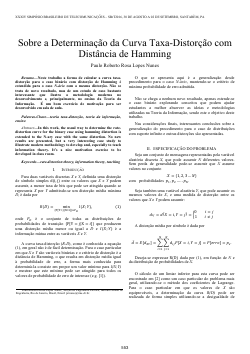
Sobre a Determinação da Curva Taxa-Distorção com Distância de Hamming
Paulo Roberto Rosa Lopes Nunes
DOI: 10.14209/sbrt.2016.227
Keywords: rate-distortion theory information theory teaching
Abstract
In this work, the usual way to determine the rate-distortion curve for the binary case using hamming distortion is extended to the N-ary case with the same distortion. No new results are presented, but a very interesting case study to illustrate modern methodology to develop and, especially to teach information theory. It’s a nice motivation exercise to be developed in the classroom.Download
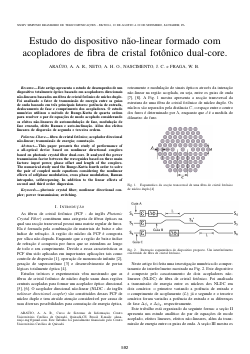
Estudo do dispositivo não-linear formado com acopladores de fibra de cristal fotônico dual-core.
ARAU´ JO, A. A. R., NETO, A. H. O., NASCIMENTO, J. C., FRAGA, W. B.
DOI: 10.14209/sbrt.2016.225
Keywords: photonic crystal fiber nonlinear directional coupler power transmission switching
Abstract
This paper presents the study of the performance of an all-optical device based on nonlinear directional couplers based on photonic crystal fiber dual-core. It analyzed the power transmission factor between the waveguides based on three main factors: input power, phase offset and length of the couplers. The numerical study used the Runge-Kutta fourth order to solve the pair of coupled mode equations considering the nonlinear effects of self-phase modulation, cross phase modulation, Raman intrapulse, self-steepening. In addition to the linear effects of second and third order dispersion.Download
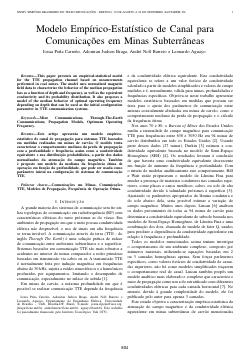
Modelo Empírico-Estatístico de Canal para Comunicações em Minas Subterrâneas
Josua Peña Carreño, Adoniran Judson Braga, André, Noll Barreto, Leonardo Aguayo
DOI: 10.14209/sbrt.2016.228
Keywords: Communications Through-The-Earth Communications Propagation Models Optimum Operating Frequency.
Abstract
This paper presents an empirical-statistical model for the TTE propagation channel based on measurements performed in coal mines. The model uses normalized magnetic field data to characterize the behavior of the median propagation loss as a function of depth and frequency, as well as the equivalent conductivity and its probability distribution. It also proposes a model of the median behavior of optimal operating frequency depending on depth that can be used as the initial configuration parameter in TTE communication systems.Download
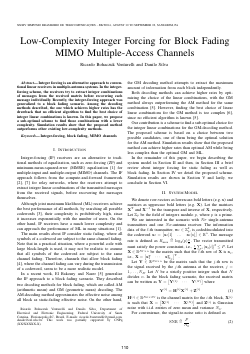
Low-Complexity Integer Forcing for Block Fading MIMO Multiple-Access Channels
Ricardo Bohaczuk Venturelli, Danilo Silva
DOI: 10.14209/sbrt.2016.2
Keywords: Integer-forcing block fading MIMO channels
Abstract
Integer forcing is an alternative approach to conventional linear receivers in multiple-antenna systems. In the integerforcing scheme, the receivers try to extract integer combinations of messages from the received matrix before recovering each message individually. Recently, the integer-forcing approach was generalized to a block fading scenario. Among the decoding methods described, the one which achieves higher rates has the drawback that no efficient algorithm to find the best choice of integer linear combinations is known. In this paper, we propose a sub-optimal scheme to find those combinations with a lower complexity. Simulation results show that the proposed method outperforms other existing low-complexity methods.Download

Performance of Single Carrier and Multicarrier With PAPR Reduction Technique in MIMO Systems
Jaime L. Jacob, Taufik Abrão
DOI: 10.14209/sbrt.2016.6
Keywords: CCDF PAPR spatial modulation (SM) V-BLAST OFDM single-carrier (SC) IBO high power amplifier (HPA) partial transmit sequence (PTS) particle swarm optimization
Abstract
We have analyzed the spatial modulation (SM) OFDM and V-BLAST OFDM systems equipped with particle swarm optimization (PSO)-based partial transmit sequence (PTS) PAPR reduction technique and not ideal side information (SI) transmission; while comparing such transmission schemes with the SM single-carrier (SC) and V-BLAST-SC systems. We observe that under 2 × 4 antennas the SM-SC and V-BLAST SC outperform the SM-OFDM and V-BLAST OFDM. For 4 × 4 antennas the V-BLAST OFDM system, in the linear region or not, results in a better performance than V-BLAST SC. On the other hand, the SM-OFDM system performs better than SM SC system under low saturation.Download
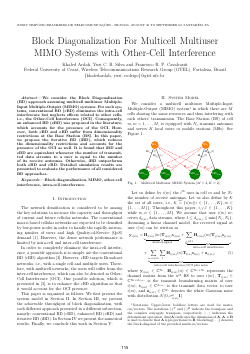
Block Diagonalization For Multicell Multiuser MIMO Systems with Other-Cell Interference
Khaled Ardah, Yuri C. B. Silva, Francisco R. P. Cavalcanti
DOI: 10.14209/sbrt.2016.20
Keywords: Block diagonalization MIMO other-cell interference intra-cell interference.
Abstract
We consider the Block Diagonalization (BD) approach assuming multicell multiuser Multiple- Input Multiple-Output (MIMO) systems. For such systems, conventional BD (cBD) eliminates the intra-cell interference but neglects effects related to other cells, i.e., the Other-Cell Interference (OCI). Consequently, an enhanced BD (eBD) was proposed in the literature, which accounts for the presence of the OCI. However, both cBD and eBD suffer from dimensionality restrictions at the Base Station (BS). In this paper, we propose the iterative BD (iBD), which reduces the dimensionality restrictions and accounts for the presence of the OCI as well. It is found that iBD and eBD are equivalent whenever the number of transmitted data streams to a user is equal to the number of its receive antennas. Otherwise, iBD outperforms both eBD and cBD. Detailed simulation results are presented to evaluate the performance of all considered BD approaches.Download
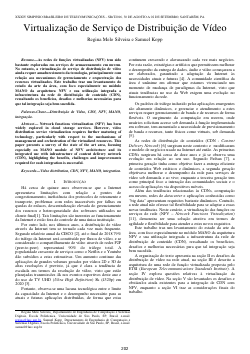
Virtualização de Serviço de Distribuição de Vídeo
Regina Melo Silveira, Samuel Kopp
DOI: 10.14209/sbrt.2016.21
Keywords: Distribuição de Vídeo CDN NFV MANO integração.
Abstract
As redes de funções virtualizadas (NFV) tem sido bastante exploradas em serviços de armazenamento em nuvem. No entanto, a virtualização de serviço de distribuição de vídeo ainda requer amadurecimento da tecnologia, principalmente com relação aos mecanismos de gerenciamento e orquestração dos recursos virtualizados. Este trabalho traz um levantamento do estado da arte da área, com foco especialmente no módulo MANO da arquitetura NFV e sua utilização integrada a infraestrutura da rede de distribuição de conteúdo (CDN), ressaltando os benefícios, desafios e melhorias necessárias para que tal integração seja bem sucedidaDownload
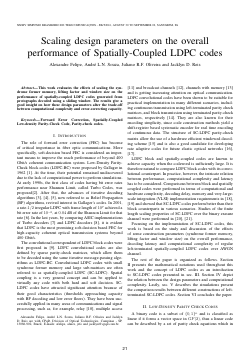
Scaling design parameters on the overall performance of Spatially-Coupled LDPC codes
Alexandre Felipe, André L.N. Souza, Juliano R.F. Oliveira, Jacklyn D. Reis
DOI: 10.14209/sbrt.2016.25
Keywords: Forward Error Correction Spatially-Coupled Low-density Parity-Check Code Parity-check codes.
Abstract
This work evaluates the effects of scaling the syndrome former memory, lifting factor and window size on the performance of spatially-coupled LDPC codes generated from protographs decoded using a sliding window. The results give a good insight on how these design parameters alter the trade-off between computational complexity and error-correcting capacity.Download